feature
A Web of Ideas
Fostering scientific discourse with spider web discussions
The Science Teacher—April/May 2019 (Volume 86, Issue 8)
By MICHAEL GIAMELLARO, JACKSON BLACKBURN, MOLLY HONEA, AND JACOB LAPLANTE
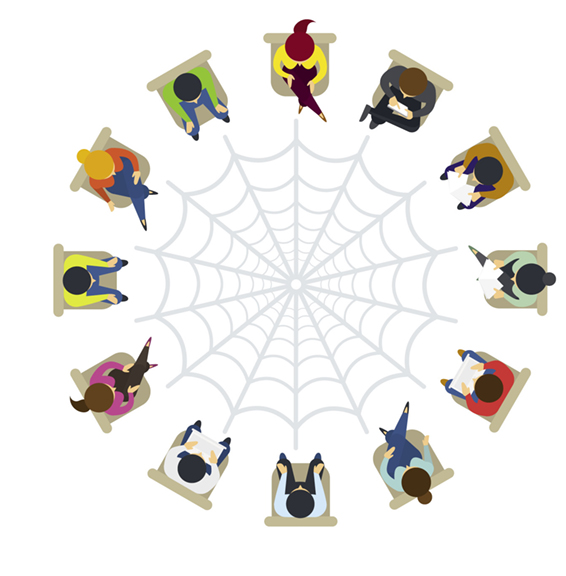
As a science teacher you have probably planned for a rich discussion in your class only to be met with blank stares from your students. Maybe you have avoided peer-to-peer discussion due to limited class time. These concerns keep many teachers from working toward rich discourse in their classrooms (Roth and Garnier 2006). This is problematic if we accept the notion that talking is thinking (Cazden 2001).
There is substantial evidence to suggest that social interactions, and discourse in particular, are the strongest drivers of learning (National Academies 2018), suggesting that we need to promote productive talk in our classrooms (NRC 2012). While the Next Generation Science Standards practice of “obtaining, evaluating, and communicating information” has an explicit connection to scientific discourse, “engaging in argument from evidence” and arguably all NGSS practices are facilitated through discourse in the real world. We need to teach students how to have a productive conversation so they can fully engage in the scientific process. Leading productive discourse can be learned and when facilitated well, leads to greater equity of voice in the classroom (Windschitl, Thompson, and Braaten 2018).
In our own search for scaffolds to help students learn how to have productive discussions, we encountered Spider Web Discussions (SWDs), an instructional routine that structures classroom talk and allows the teacher to monitor the content and process of the discussion (see “On the web”). We have found SWDs to be a powerful tool that allows students to reflect on their content knowledge and wrestle with socio-scientific issues facing us. Students are also excited about the gamification of the process and regularly ask for SWDs.
How to run it and what it looks like
In an SWD students have a meaningful conversation about an important topic. The teacher graphs the flow of the talk to assess the quality and equity of the discourse, as well as the quality of the content that students present. Ideally, students are seated in a circle (Figure 1), and as each student participates in the conversation, the teacher draws a line from one speaker to the next on a diagram of the students’ seats, creating what looks like a spider web (Figure 2, p. 50). The teacher also makes notations on the web about the quality of the talk.
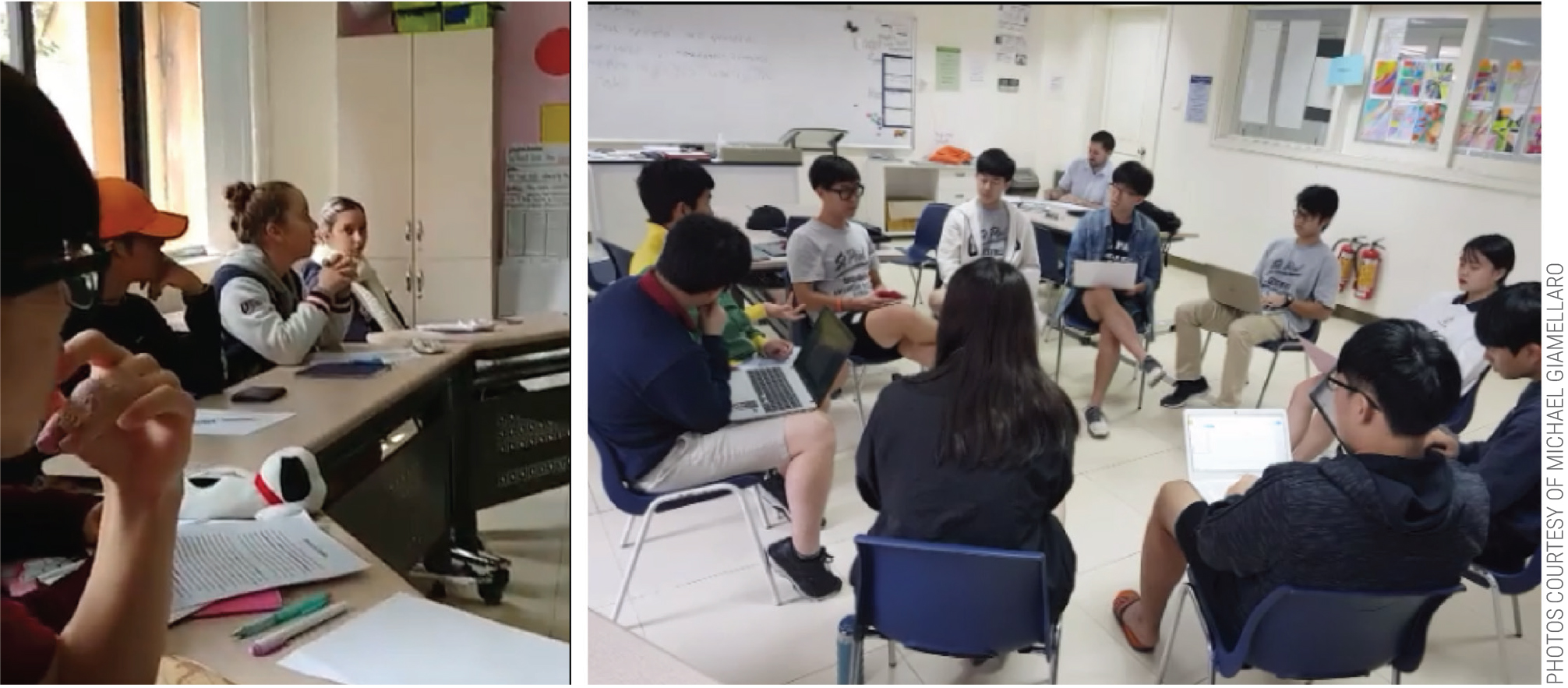
Students engaged in spider web discussion
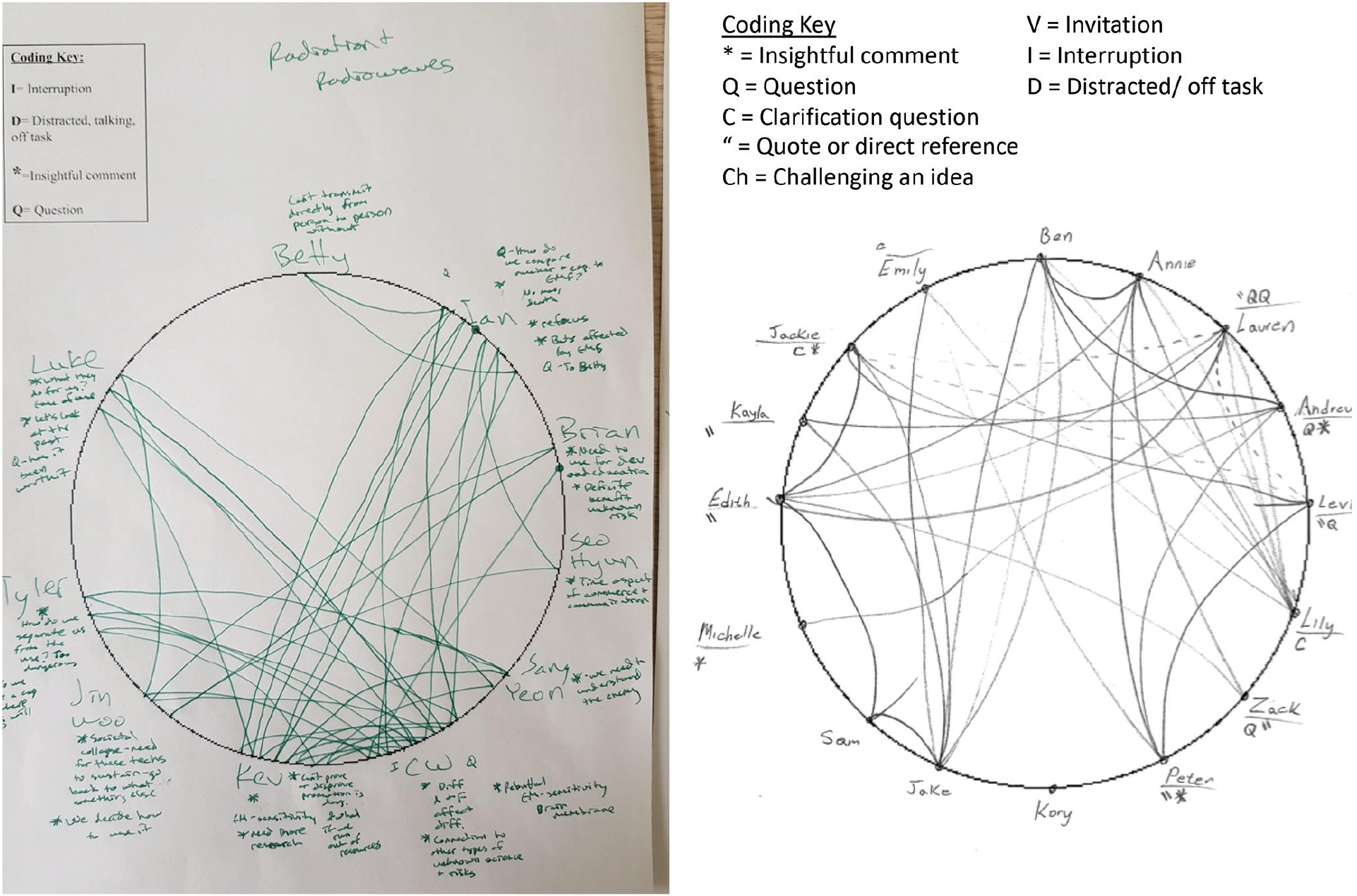
Class diagram of spider web discussion
We have found that displaying the developing web on a projector in real time can improve the process by giving students ongoing feedback of who needs to be brought into the conversation and who should yield the floor to peers. With repeated use, discourse skills become automatic for students, giving them tools for productive talk outside of the SWD format. At the conclusion of the conversation the students self-assess the web and discuss what they could improve on the next time. We have found that our students are invested in making better webs, so the quality of the conversations improves over time.
Preparing for a Spider Web Discussion
The success of SWDs hinges on the teacher’s preparation for the activity. The teacher must select an important idea for students to discuss (for examples, see Figure 3, p. 52) and make sure students are adequately prepared. This may mean providing prompts and research time ahead of the discussion or recognizing that other class activities have prepared students for the discussion. Students are most successful and more comfortable sharing ideas when they have organized, written notes and ideas in front of them during the discussion. SWDs can be used to present a problem that must be solved, to collectively design an investigation, to discuss data, as a scientific argumentation session, or for any other purpose that is open to multiple voices and multiple interpretations. SWDs are not well suited for establishing a singular idea or landing on a set of facts.
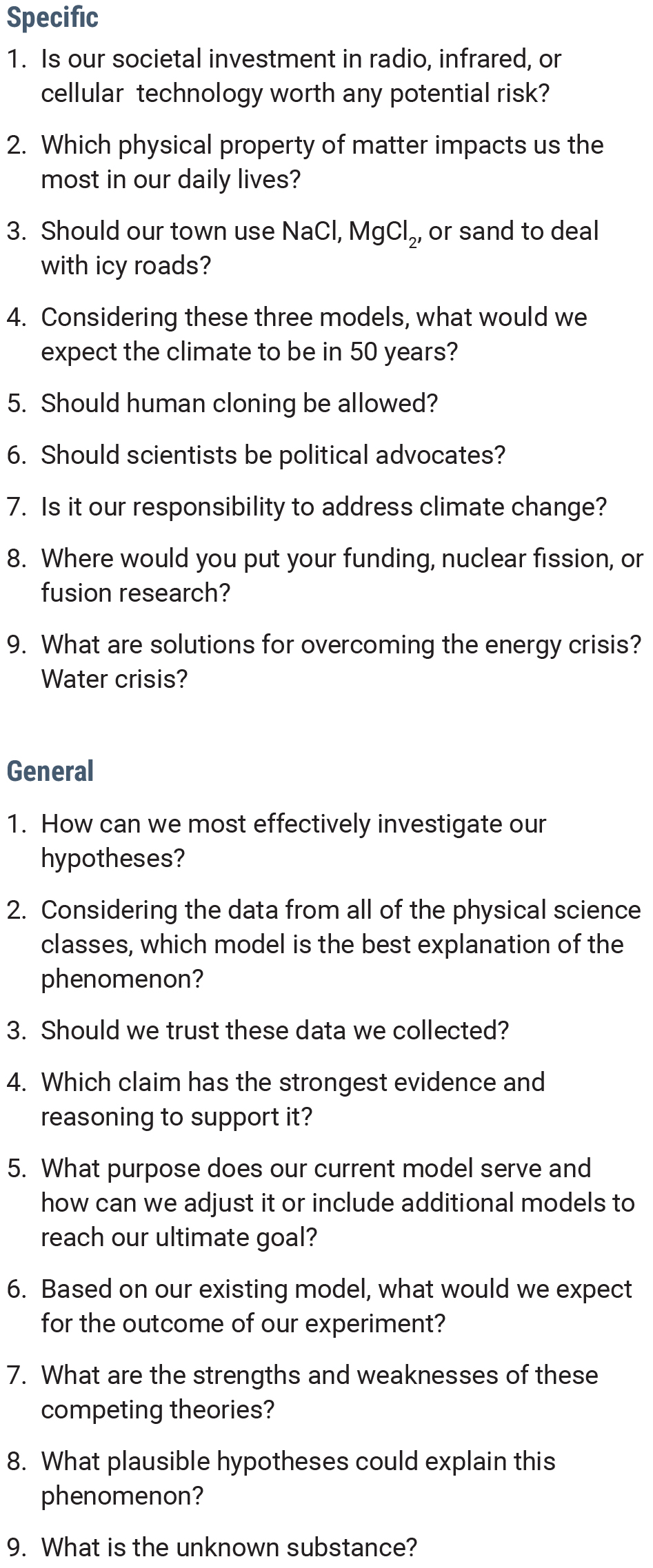
Examples of high-leverage spider web discussion prompts
Before the discussion, help students prepare by framing the purpose: to elicit students’ ideas, support ongoing changes in student thinking, or draw together evidence-based explanations (Windschitl, Thompson, and Braaten 2018). While it may seem natural to use SWDs as a culminating activity for a unit, we have found them to be powerful tools throughout a unit and particularly when students are expressing their initial ideas about a phenomenon.
During the discussion
Handing control of the discussion to students can feel uncomfortable at first, and there may be some awkward starts and stops. We find, however, that the feedback of the spider web keeps students on track and allows us to monitor what is being shared rather than focusing on the next thing the teacher needs to say. At times we will assign specific roles for students (Figure 4, p. 53). In an ideal discussion, the teacher is silent, making notes on the spider web as the conversation proceeds and only intervening when the discussion seems to be getting off track.
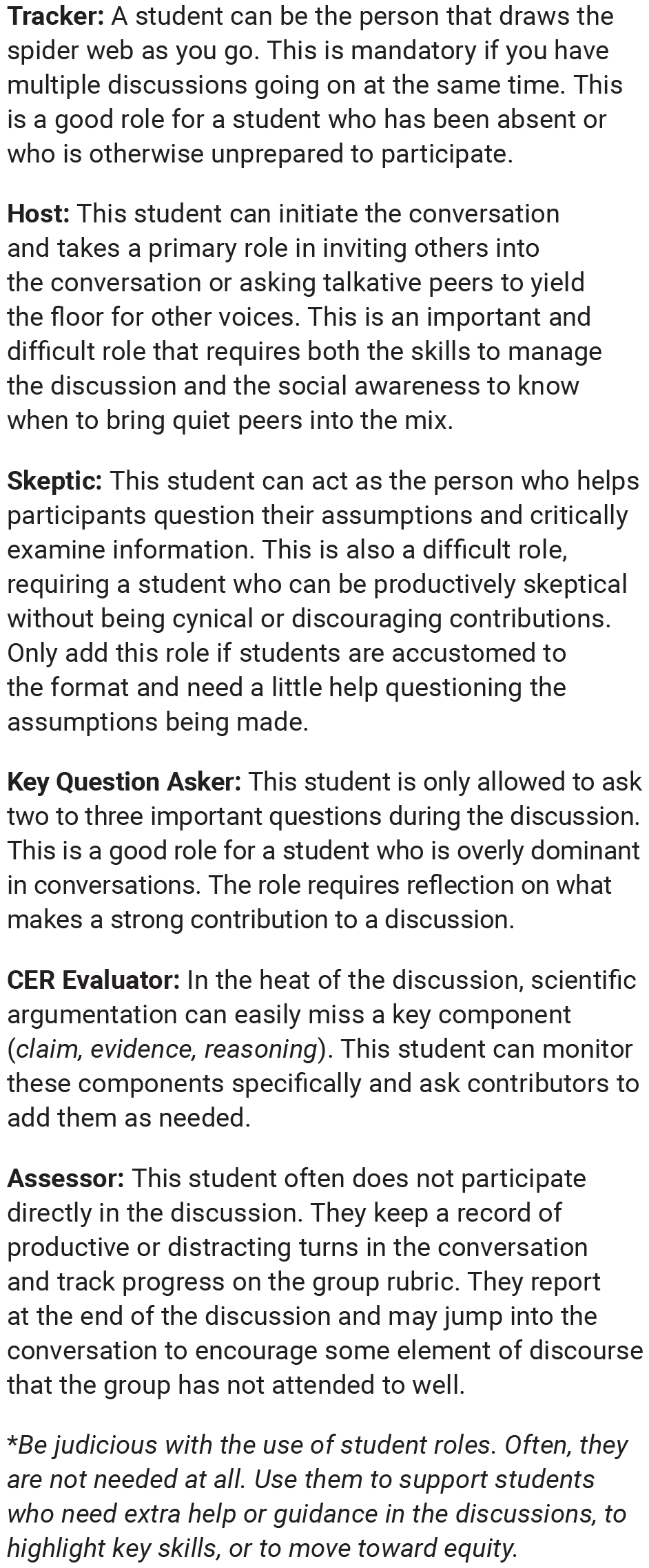
Student roles that can be assigned for the discussions. Be judicious with the use of student roles. Often, they are not needed at all. Use them to support students who need extra help or guidance in the discussions, to highlight key skills, or to move toward equity.
We try to keep the notation simple to provide instant feedback to the students on the quality and the content of the discussion. In the science classroom we use the notations to reward contributions that bring in relevant data or background knowledge, use evidence to support a position, invite a peer into the conversation, ask a peer to support his or her position with evidence, and synthesize the ideas of multiple students (Table 1). The notations also allow students to see the difference between contributions that move the discussion forward and tangents. In a large class, it can be helpful to use concentric circles or split the class into smaller groups with assigned student recorders.
| Useful notations for marking up the spider web. | ||||||||||||||||||||
|---|---|---|---|---|---|---|---|---|---|---|---|---|---|---|---|---|---|---|---|---|
|
The teacher’s role in SWDs evolves over time. As the expert in the room, the teacher has an important voice in the conversation but not the only voice. It is best for the teacher to not speak during the discussions at first, unless there is a threat to an emotionally safe learning environment or the discussion moves off course for an extended period. After the class gets used to the format, the teacher can join the conversation as another participant, not the conversation leader. You and the students will quickly notice on the web if you are talking too much! It is powerful for your students to see you modeling scientific reasoning as well as the norms for productive discourse when you defer to other speakers and weave yourself into the conversation rather than running it.
Attending to equity
Scaffolding discourse skills is a strong approach to increasing equity for your students. Effective communication skills affect almost every aspect of students’ future academic and professional lives. However, equity is not automatic in discussions. The first step for supporting equity during classroom discussion is to make sure that everyone has thoughts, ideas, and information to contribute to the conversation.
Use your knowledge of your students to differentiate accordingly. Some students may be able to run with a simple research prompt while others will benefit from additional supports, down to the level of sentence frames they can use. By making sure that each student has something productive to share, you decrease the risk that they will be excluded from the conversation. English language learners (ELLs) benefit from vocabulary lists, science notebooks, prepared notecards, and “pregame” sessions where they can practice sharing ideas. It can be useful to pair ELLs with another student with whom they can rehearse potential discussion exchanges.
As with any classroom discourse, a safe space must be created for sharing ideas. Students should be introduced to an initial set of norms for productive discourse that will support equity of voice during the discussion. Keep the list simple, memorable, and posted as a public record. More importantly, revisit the list regularly and give students the opportunity to propose changes to the norms as the class learns to work and talk together. Setting all students and the group up for success is the goal. Assigned seating can help with this; we have had success with putting those who are good at questioning or students who tend to dominate in direct view of the spider web to help them share the floor.
Assessment
While SWDs are powerful tools for supporting student thinking and discourse skills, we have also come to appreciate their effectiveness as assessment tools. Following an SWD, the teacher should have a sense of whole-class and individual students’ understanding of the subject, and can be responsive to the discussion results right away. The other side of formative assessment—the idea that students should be able to use it to directly improve understanding—is often forgotten about. SWDs facilitate that metacognition at the concluding reflection and also in real time as the conversation is captured in the web.
It is useful to stop the conversation midway to ask students how the web is forming and what could be done to improve it. After the discussion, it is imperative to give students time to evaluate the web. Ask students to identify particularly important moments in the conversation, in both discourse and in making sense of the science content. This can be started effectively in small groups, but students should be asked to have a final conclusion of their own in order to help the teacher identify students who might need targeted interventions on skills and content knowledge.
We recommend assigning group grades rather than individual grades for the SWDs. This simple change transforms the discussion from a competition to a shared sense-making endeavor. The students are incentivized to contribute and also to encourage others to contribute as they are graded on the overall distribution of the web. We also recommend a standing SWD grade that can be improved over time without the negative consequences of the first few being a bit bumpy. We have each designed our own rubrics to assess the discussions, specific to our own teaching contexts, and have found this easy to do.
Students learn that a full range of ideas not only makes the web better but also makes the conversation better. Students are more apt to support each other in the preparation stages and are more apt to listen to each other so they can circle back to synthesize ideas. An “assist” in getting an idea out is just as valuable as having a “lightbulb moment.”
Conclusion
In Figure 5 we present some suggestions for science-specific uses of SWDs to accompany the generalized description above. Productive discourse is one of the most powerful tools in the science teacher’s toolbox, and building toward it can be relatively easy with the right scaffolds. We all tried introducing the practice in our very different classrooms with a healthy dose of skepticism. After using it regularly, we believe SWDs have much potential across a wide variety of contexts if teachers trust the process, take the time to prepare students, and give students the opportunity to improve over time.
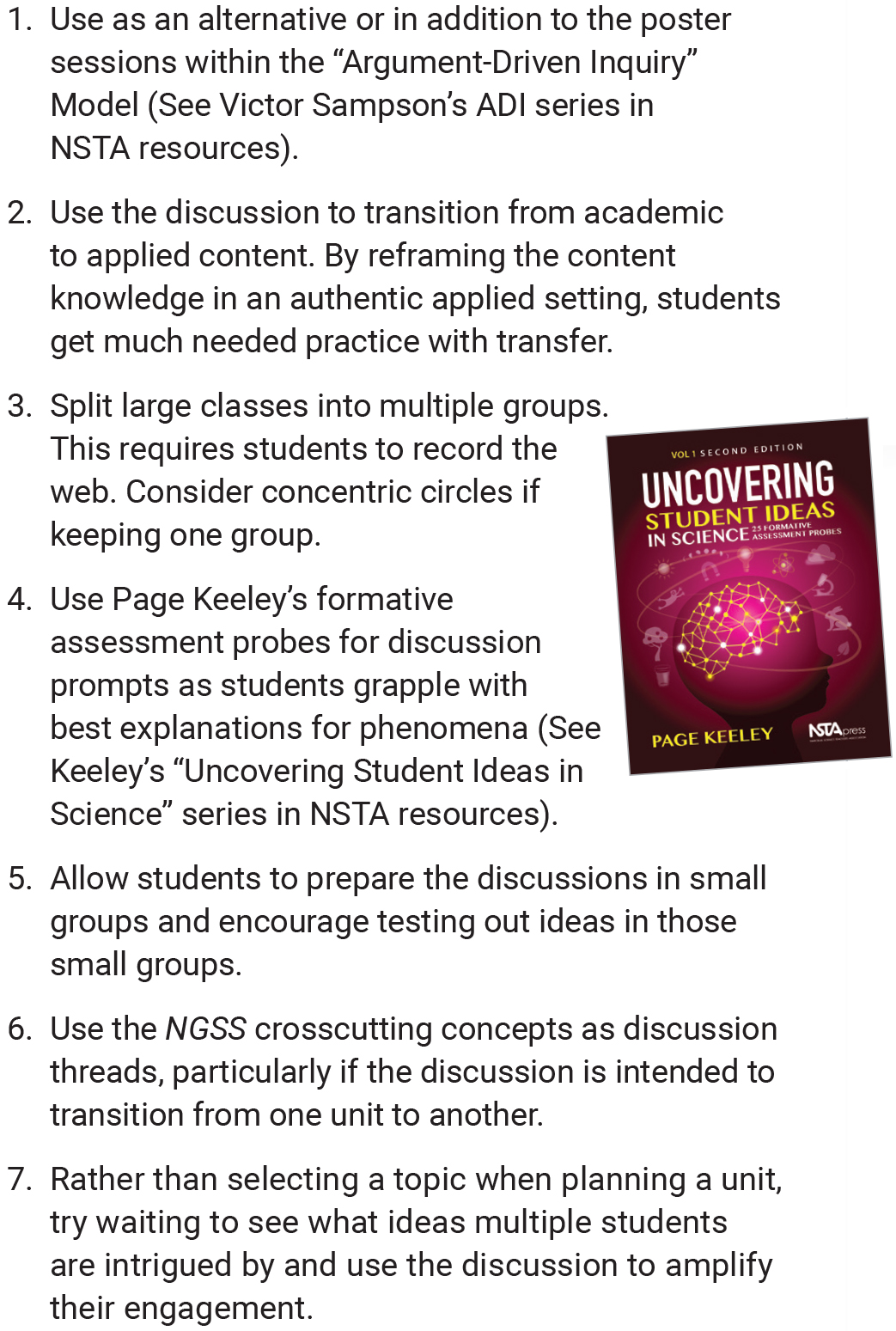
Variations for using spider webs in the science classroom
Michael Giamellaro (giamellm@oregonstate.edu) is an assistant professor of science and mathematics education in the College of Education, Oregon State University, Bend, Oregon. Jackson Blackburn and Jacob LaPlante are science teachers at the St. Paul American School, Hanoi, Vietnam. Molly Honea is a science teacher at LaPine Middle School, LaPine, Oregon.
Pedagogy Science and Engineering Practices Teaching Strategies Middle School High School


